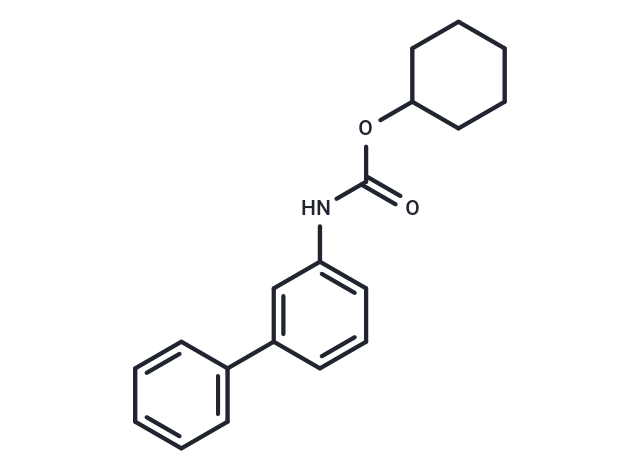Shopping Cart
- Remove All
 Your shopping cart is currently empty
Your shopping cart is currently empty

URB602 is a specific monoacylglycerol lipase (MGL) inhibitor, which inhibits rat brain MGL (IC50: 28±4 μM) through a noncompetitive mechanism.

| Pack Size | Price | Availability | Quantity |
|---|---|---|---|
| 25 mg | $38 | In Stock | |
| 50 mg | $68 | In Stock | |
| 100 mg | $119 | In Stock | |
| 200 mg | $175 | In Stock | |
| 1 mL x 10 mM (in DMSO) | $29 | In Stock |
| Description | URB602 is a specific monoacylglycerol lipase (MGL) inhibitor, which inhibits rat brain MGL (IC50: 28±4 μM) through a noncompetitive mechanism. |
| Targets&IC50 | MGL:28±4 μM |
| In vitro | The apparent Km of MGL for 2-AG is 24±1.7 μM and the Vmax is 1814±51 nmol/min/mg protein; with URB602, the Km is 20±0.4 μM and the Vmax is 541±20 nmol/min/mg protein (n=4). When organotypic slice cultures of rat forebrain are incubated with URB602 (100 μM), both baseline and Ca2+-ionophore-stimulated 2-arachidonoylglycerol (2-AG) concentrations are increased[1]. URB602 weakly inhibits recombinant MGL (IC50: 223±63 μM) through a rapid and noncompetitive mechanism. |
| In vivo | URB602 (20-40 mg/kg) can reduce upper GI transit and slow colonic propulsion. In whole gut transit, URB602 dose-dependently inhibits transit (P<0.05) compared with the vehicle control group. The inhibitory action of URB602 (40 mg/kg) on whole gut transit is absent in these mice, demonstrating CB1 receptor involvement in the inhibitory action[3]. During the early phase of the formalin test, URB602 decreases the AUC of pain behavior for JZL184 (ED50: 0.06±0.028 μg) and for URB602 (ED50: 120±51.3 μg) in adult male Sprague-Dawley rats. Both MGL inhibitors also suppress pain behavior during the late phase of formalin pain for JZL184 (ED50: 0.03±0.011 μg) and for URB602 (ED50: 66±23.9 μg). |
| Kinase Assay | Samples containing either URB602 (300 μM), MGL (1.4 pM), or both URB602 and MGL are incubated at 37°C for 30 min in assay buffer. At various time points, the reaction is stopped with an equal volume of ice-cold methanol and directly analyzed in positive ionization mode by LC/MS. A SB-CN column (150×2.1 mm i.d., 5 μm) eluted is used with a linear gradient of methanol in water containing 0.25% acetic acid and 5 mM ammonium acetate (from 60% to 100% of methanol in 8 min) at a flow rate of 0.5 mL/min with column temperature at 50°C. Capillary voltage is set at 4 kV and fragmentor voltage is 100V. Nebulizer pressure is set at 60 psi. N2 is used as drying gas at a flow rate of 13 liters/min and a temperature of 350°C. ESI is in the positive mode and a full scan spectrum is acquired from m/z 100 to 600. Extracted ion chromatograms are used to quantify URB602 ([M+H]+, m/z 296)[2]. |
| Molecular Weight | 295.38 |
| Formula | C19H21NO2 |
| Cas No. | 565460-15-3 |
| Smiles | O=C(Nc1cccc(c1)-c1ccccc1)OC1CCCCC1 |
| Relative Density. | 1.149g/cm3 |
| Storage | Powder: -20°C for 3 years | In solvent: -80°C for 1 year | Shipping with blue ice/Shipping at ambient temperature. | |||||||||||||||||||||||||||||||||||
| Solubility Information | DMSO: 55 mg/mL (186.2 mM), Sonication is recommended. | |||||||||||||||||||||||||||||||||||
Solution Preparation Table | ||||||||||||||||||||||||||||||||||||
DMSO
| ||||||||||||||||||||||||||||||||||||

Copyright © 2015-2025 TargetMol Chemicals Inc. All Rights Reserved.